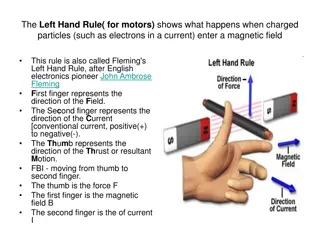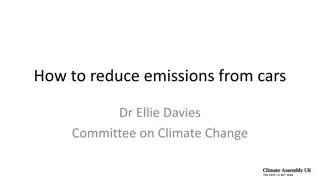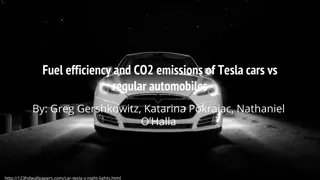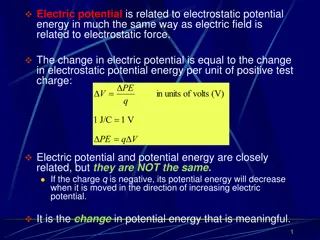Unlocking the Potential of Electric Cars for Climate Action in 2022
Electric vehicles (EVs) can greatly reduce greenhouse gas emissions compared to gasoline cars, thanks to advancements in battery technology. The shift towards lithium-ion batteries has revolutionized the EV market, making them more efficient and reliable. Understanding the components of EV batteries, such as cells, modules, and packs, is crucial for grasping their environmental benefits. Explore why EVs are becoming key players in combating climate change.
Download Presentation

Please find below an Image/Link to download the presentation.
The content on the website is provided AS IS for your information and personal use only. It may not be sold, licensed, or shared on other websites without obtaining consent from the author.If you encounter any issues during the download, it is possible that the publisher has removed the file from their server.
You are allowed to download the files provided on this website for personal or commercial use, subject to the condition that they are used lawfully. All files are the property of their respective owners.
The content on the website is provided AS IS for your information and personal use only. It may not be sold, licensed, or shared on other websites without obtaining consent from the author.
E N D
Presentation Transcript
Find Out Why Electric Cars Can Help 2022 Climate Superstars Task #9
Learning Objectives After completing this task, you will be able to Explain the differences between electric vehicle battery components: a cell, a module, and a pack. Explain what the three acronyms EV, PHEV, and HEV stand for. Name several recent model electric cars.
Vocabulary Battery cell - basic unit of a battery that exerts electric energy by charging and discharging Battery module - a battery assembly put into a frame by combining a fixed number of cells Battery pack - final shape of the battery system installed in an electric vehicle (e.g., 8 modules (12 cells per module) go into a battery pack Carbon footprint - the total amount of greenhouse gases (including carbon dioxide and methane) that are generated by our actions Greenhouse gas emissions gases that trap heat in the atmosphere including carbon dioxide, methane, and nitrous oxide
Gasoline Powered Cars vs EVs Electric vehicles typically have a smaller carbon footprint than gasoline cars, even when accounting for the electricity used for charging. Over the lifetime of an electric powered vehicle, total greenhouse gas (GHG) emissions associated with manufacturing, charging, and driving are typically lower than the total GHGs associated with a gasoline powered car. That s because EVs have zero tailpipe emissions and are typically responsible for significantly fewer GHGs during operation. Source: EPA
An Old Idea is New Again The electric vehicle was, in fact, developed before the internal combustion engine vehicle, but it did not become the mainstream in the market due to inefficient battery technology. This is changing. Behind the EV revolution is a shift to the lithium- ion battery from lead, nickel-cadmium, and nickel-metal-hydride batteries. Why? Longer life, higher energy density, and better reliability. As battery technology advances, more and more automakers are introducing electrified models. To operate an electric vehicle (EV), an enormous amount of power a thousand times stronger than that of a smart phone is required. That is why EVs need from dozens of battery cells up to many thousands. The composition of an EV battery might vary slightly depending on the type of electric vehicle, but generally EV batteries are composed of cells, modules, and a pack.
Cells and Modules Let's examine each term one by one. A cell, which is the basis of a battery, must possess high energy density. The cell also needs to have a much longer lifespan compared to batteries used in general devices. Furthermore, cells must endure shocks (e.g. heat and vibrations) during driving, possess high reliability, and performance stability to the extent of being able to withstand high and low temperatures.
Cells + Modules = Packs When a number of cells are put into a frame to protect them better from external shocks this is called a module. When a number of modules are combined with a battery management system and a cooling device, to control and manage temperature, voltage, etc., this is called a pack. This is how the numerous cells needed to power an EV are installed, through the use of a battery pack.
What are the Different Types of Electric Cars? There are three: purely electric vehicle (EV), plug-in hybrid EV (PHEV), and hybrid EV (HEV). An EV has only electric motors that run on battery power. A PHEV uses both a gasoline powered engine and one or more electric motors with a battery pack that can be charged by external power. A PHEV first uses battery power until the stored electricity is used up, then the fossil fuel engine takes over. A HEV uses both an internal combustion engine and one or more electric motors to maximize energy efficiency and minimize environmental pollution. Mainly it is powered by an engine for general driving, and battery assistance when extra power is needed. It charges the battery pack with its own power, so there is no need for infrastructure like charging stations.
Hybrid and Electric Cars on the Market There are plenty of hybrid and electric cars on the US market. Check out this list of 2022 models.
Find a photo of your favorite electric car or draw an electric car of the future and take a picture of your drawing, then upload it using the form below. Action Item Paste an image of your favorite electric vehicle here. What are the alternative transportation options in your community that don't involve a car?























